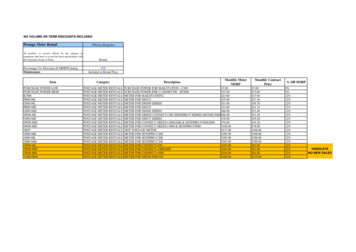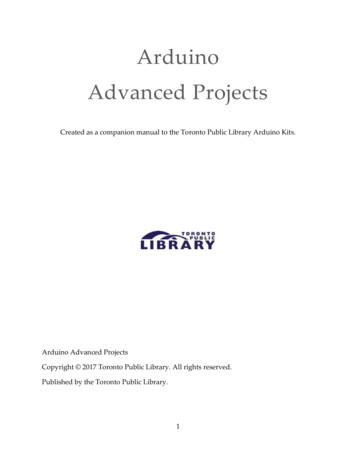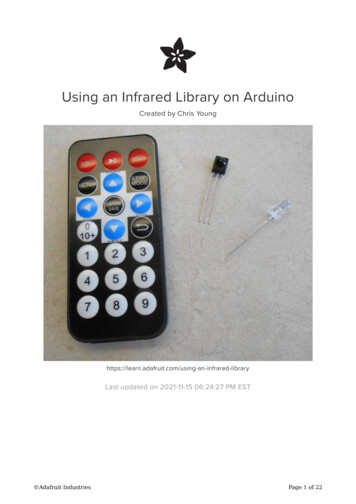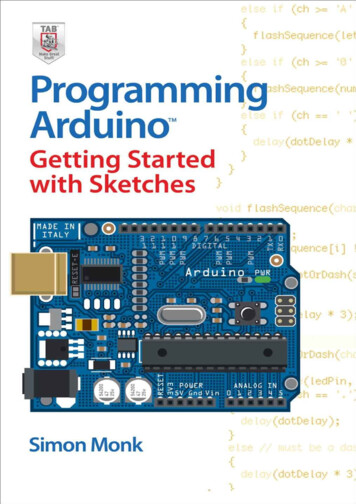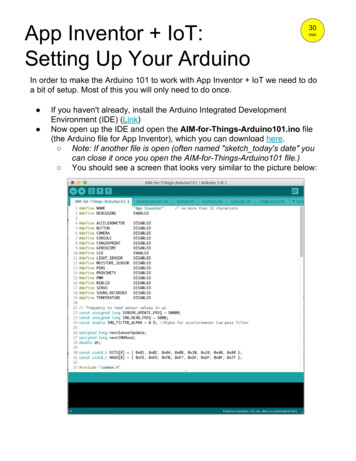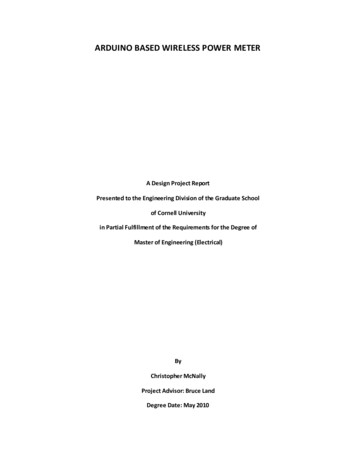
Transcription
ARDUINO BASED WIRELESS POWER METERA Design Project ReportPresented to the Engineering Division of the Graduate Schoolof Cornell Universityin Partial Fulfillment of the Requirements for the Degree ofMaster of Engineering (Electrical)ByChristopher McNallyProject Advisor: Bruce LandDegree Date: May 2010
AbstractMaster of Electrical Engineering ProgramCornell UniversityDesign Project ReportProject Title: Arduino based wireless power meterAuthor: Christopher McNallyAbstract:One avenue through which today’s energy problems can be addressed is through the reduction ofenergy usage in households. The existing utility system only provides feedback at the end of the monthin the form of a bill and consumed kilowatt hours (kWh). A homeowner has no way to track their powerusage on a more immediate basis.The Arduino based wireless power meter is a non-invasive current meter for household power with aMatlab interface. Current is measured using split core current transformers. This data is thentransmitted over a 802.11b connection through the home’s wireless router to the base station andMatlab interface. The project aims to provide a clear picture of a home’s current usage, and through thisdata provide an estimate to power consumption. The project also aims to identify which devices turn onand off by analysis of this current data. The goal of provided such data to a user is that they will optimizeand reduce their power usage.Report Approved byProject Advisor: Date:1
Executive SummaryThe Arduino based wireless power meter centered on the design and development of a currentmeasurement device with an IEEE802.11b link to a base station running a graphical user interface (GUI).The project’s goal was to present a user with energy usage information in the hopes that they could usethe information to optimize and reduce their energy consumption.The system was comprised of the current transducers and their rectifier circuitry, the main Arduinoboard, the WiShield add-on board, and the base station computer. The software portion of the projectresided on the Arduino board and on the base station computer. Current was measured from the twocurrent carrying wires into the main power panel, sampled by the Arduino board, and then sent as aUDP packet over the Wi-Fi network to the base station computer. The base station’s software thenparsed the packet, and converted the raw analog to digital conversion into current data, w here it couldbe used to either display current usage to the user, or estimate apparent and real power for display tothe user.The project succeeded on most fronts. The update rate of data from the embedded side of the projectto the base station was 20 Hz, with a measurement resolution of the RMS current of about 47.5 mA. Thisresolution allowed small changes in the current draw of the house to be visible while examining data.When compared to a consumer grade Wattmeter, the current measurement data showe d an error ofapproximately 4.96% while measuring a purely resistive load consuming 180 W.The wireless connection between the embedded electronics and base station was reliable for thenetworking equipment used. However, the 802.11b module used on the embedded side was notcompatible with some wireless routers, meaning a user would have to change their router if theyhappened to be using an incompatible router. Range of the device seemed to be on par with most other802.11b devices.The feature of automatically detecting which devices turn on when based on the current data was notsuccessful. Based on the data collected, the change in turn on current only differed significantlybetween devices by magnitude, not waveform. This meant the origi nally intended method of crosscorrelation between the incoming data and reference turn on data would not be effective. A method ofidentifying devices based on the magnitude of changes also proved to be unreliable. If more than onedevice powered on at once (such as a light switch turning on a room full of devices), the measurementswould only see the net difference in current draw. This would lead to inaccuracies in device detection,and so the feature was dropped from the system.2
Table of Contents1Introduction .41.1. Household Power .41.2. System Requirements .42System Design .52.1. Hardware .52.1.1. Overview .52.1.2. Arduino Duemilanove . .52.1.3. WiShield . 62.1.4. Current measurement .62.2. Software . .92.2.1. Arduino software . .92.2.2. Base station interface . 103Results .114Conclusion . 135Appendix 145.1. Figures 145.2. Source code .173
1 IntroductionIn the existing power utility set up, consumers are presented with usage information only once a monthwith their bill. The length of time between updates about power usage is far too long for a consumer toobserve a changed behavior’s effect on power usage. In addition utility bills can be convoluted in howthey present usage information, and a consumer may not be able to decipher changes in their powerusage from the last bill. An opportunity to educate customers on power usage is lost because of theserealities.If a person can instantaneously see how much power leaving a device on by accident consumes perminute, they may be more careful in the future about letting devices run when not needed. The goal ofcreating more awareness about energy consumption would be optimization and reduction in energyusage by the user. This would reduce their energy costs, as well as conserve energy.1.1 Household powerIn most US households, power comes into the house through a three wire, split phase connection. Two“hot” wires carry current into the circuit breaker. A neutral wire also provides a connection to groundfor the house circuit. Each hot wire has an RMSvoltage of 120V /- 5%. The wires are set up sothat the AC waveforms are 180 , so that bothlines combined can provide a 240V source forlarger household appliances.The apparent power consumed by a householdcan be found by taking the product of the RMSvoltage and total RMS current. The real powercan be calculated from discrete samples bytaking the average of the product of the voltageFigure 1. US household three wire power connection [1]and current samples over a specified window.Power factor can then be calculated by dividingreal power by the apparent power. This project only included current measurements, and thus bothpower measurements are estimates, as opposed to measurements.1.2 System requirementsThe goals of the project were as follows: Accurately collect a house’s total current consumption safely, and with a relatively fast updaterate.Transmit the information back to a base station to be represented visually to a userIdentify when devices in the household turn on and off based on changes in the curre nt data4
To ensure the safety of the user and the ease of installation, a non-invasive method of measuringcurrent was required. This meant that the current measurement circuit could not be in series with themains power line, and could not require the disconnection of the line for any reason.The wireless connection had to be able to integrate into the user’s home network, and comply with theIEEE802.11b standard. The data rate of the wireless connection also had to be sufficient to support therequired update rate. The overall speed of both the wireless connection protocols had to be sufficientlyfast that it would not interfere with obtaining the required amount of samples in a given period.2 System design2.1 Hardware2.1.1 OverviewThe hardware of the system consists of three parts: sensor capture, the MCU board, and the wirelessboard. The sensor capture hardware consists of the current transducers and rectifi er circuit, connectedto the analog to digital converter (ADC) of the MCU. The MCU board is a standalone ArduinoDuemilanove development board. The wireless board is a shield designed to pair with the Duemilanove,created by AsyncLabs. A system overview can be seen in the appendix.2.1.2 Arduino DuemilanoveThe Duemilanove is a self contained USB development board centered on an ATMega328P. Theoperating voltage for most of the board is 5V, provided by an onboard voltage regulator. Power for theboard can come from the USB connection, the 9V DC connection, or a battery connected to the V INterminal. For this project, the 9V DC connection was used for power. A detailed schematic of the boardcan be found in the appendix.The current measurement circuit connects to the Arduinoboard through analog pins 0 and 1. This allows the Arduinoto sample the output voltage from the currentmeasurement circuit with the ATMega328’s 10-bit ADC. Avoltage of 3.3V was applied from the USB to serialconverter chip to the voltage reference pin, A REF, in order toprovide the ADC with the required reference voltage.Connections to the ground and V CC pins were also providedfor the op amp in the precision rectifier.Figure 2. Arduino Duemilanove board [2]The USB connection on the board was used for programmingthe chip and getting serial output for troubleshooting. The interface between USB and the ATMega328’sUART was provided by the Arduino’s built in USB to serial converter chip. The device showed up as avirtual COM port on the host PC, and could be interfaced with any program capable of reading andwriting to a serial port.5
The board came pre-built from the distributor, so no major hardware assembly was required for use.Female headers are attached to each of the I/O and power ports, allowing wires to be inserted ratherthan soldered to each connection. The connections to the A REF pin, the analog pins, and the ground/V CCpins were all wired in this way. No major modifications of the stock hardware were required.2.1.3 WiShieldThe WiShield contains an 802.11b compliant wireless module that handles the network, data link, andphysical layers of the design’s wireless connection. The board also includes required loading circuitryand a PCB antenna. A detailed schematic of the board can be found in the appendix.The WiShield communicated with the Arduino main board through an SPI link and an interrupt line. Thebi-directional SPI link allowed the Arduino to issue commands and send data to the 802.11b module,while the module could send received data back to the Arduino. The WiShield’s connections to theArduino are detailed in Table 1.DescriptionSlave select (SS)Arduino pin10ATMega328 pinPortB.2Clock (SCK)Master in, Slave out (MISO)Master out, slave in (MOSI)MCU interruptLED connection ble 1. WiShield connections to ArduinoThe board came preassembled from AsyncLabs, thus no major hardware assembly was required for thewireless portion of the circuitry. Female headers with male leads underneath were included on theboard, so that the WiShield was inserted into the Arduino main board’s female headers with nosoldering required.The system had known compatibility issues with some routers, as detailed on the AsyncLabs wikipage[3]. A Netgear WRN2000 was used as the router for this project because it was confirmed to becompatible by AsyncLabs. The router limitation was directly from limitations of the 802.11b moduleused, thus no software work around was attempted. For a production system this would represent aproblem, but for a proof of concept system this was considered an acceptable limitation.2.1.4 Current measurementA split core current transducer was chosen as the current sensorof the project because of its non-invasive nature. The sensor canbe clamped onto the mains lines without interrupting powerinto the circuit breaker. Avoiding interrupting the lines into thecircuit breaker makes the installation of the sensors both saferand easier. One sensor is clamped onto each “hot” wire going6Figure 3. CR3110 current transducer [3]
into the circuit breaker. The total current being drawn by the household is the sum of the measuredcurrent in both wires.The output of the current transducer is an AC voltage proportional to the AC current enclosed by thesensor’s ring. The amplitude of the voltage waveform is determined by this equation:𝑉 𝐼 𝑅𝟑𝟏𝟎𝟎Where V is RMS AC voltage across the burden resistor, I is the RMS AC current enclosed by thetransducer, and R is the resistance of the burden resistor. This equation means that the output range ofthe sensor is determined by the selection of the burden resistance R. Selecting a higher burdenresistance scales the output higher, providing a greater resolution of currents measurement. A higherresistance also means a smaller range of current measurement, and potentially damage to the MC U ifthe current is higher than intended for the design. When sizing the burden resistor, the range of linearbehavior must also be taken into account. Figure 3 show the linear limit of the sensor with a dotted line.Measurements made beyond this limit will not follow the equation given above.Figure 4. Voltage output from CR3110 [4]The burden choice for this design rested on two points: maximum resolution given the availablereference voltages on the Arduino, and selecting an appropriate range for measuring household current.A reference voltage of 3.3V was selected as the best option for the ADC, which meant that V MAX of theAC voltage signal had to be at or just below 3.3V. A burden resistance of 138.9 Ω would scale the outputof the sensor to be 3.3V V MAX at the edge of the linear region, providing the largest range and resolutionfor the given reference voltage. A resistance of 150 Ω was used as an approximation due to theavailability of resistors of that type. In this configuration, the maximum current that could be measuredwith the system was 48.2 A per line, giving a total range between both sensors of 96.4 A. For anapartment or small to medium household, this range worked well in testing. A large r range may benecessary for larger homes.The VAC output of the sensor could not directly interface with the Arduino board because of themaximum limits of reverse voltage on the MCU pins. A rectifier was therefore required to ensure that anegative voltage would not be applied to the pins of the MCU. Two rectifier circuits were considered forthis role: a full wave rectifier using a diode bridge, and a half wave precision rectifier an op amp. The7
diode bridge was also paired with a smoothing capacitor and discharging resistor in hopes of reducingthe voltage ripple.Figure 5. Full wave bridge rectifier with smoothing capacitor [5]This design proved inadequate due to the forward voltage drop of the bridge rectifier and response torapid changes in current. The forward voltage drop of the device used was around 1.1V, and dependedon the current flowing through the device. A voltage drop this large essentially meant that currentsbelow 1/3 of the maximum voltage would not be detected at all. In addition, accuracy of the voltagemeasurement was not certain due to the forward voltage drop changing with the amount of currentgoing through the device. The smoothing capacitor also proved problematic because it either greatlyreduced the response time of the circuit to rapid changes in the primary current, or let some of the ACwaveform pass through to the ADC.A precision rectifier is built around an op amp, two diodes, and two resistors. Using this circuit instead ofthe diode bridge solved the forward voltage drop problem, because the op amp corrects the output forany voltage loss over the two diodes. AC ripple was allowed to reach the analog pin and dealt with insoftware.Figure 6. Precision rectifier [6]2.2 SoftwareThe software side of the system was split into the programs running on the Arduino and the GUI runningon the base station. The Arduino was responsible for both capturing the output of both current sensors,and sending the measured data with timestamps over the wireless connection to the base station. The8
base station was responsible for reading the packets from the Arduino, converting the raw data intocurrent/power information, and presenting it to the user in a clear fashion.2.2.1 Arduino softwareData captureSampling of the voltage output of the current measurement circuit was done using the ADC on theATMega328. The Arduino IDE included a family of functions for controlling and retrieving data from theADC. The initial setup of the ADC was done using the analogReference(SOURCE) command, which setwhich reference voltage the ADC will use in its conversions. The external voltage reference option wasset for this project in order to use a reference voltage of 3.3V. The function analogRead(port) returned avalue between 0 and 1023, reflecting the level of voltage on the specified analog pin. AnalogRead()typically took around 100 µs to execute and return the conversion value.As described in section 2.1.4, the smoothing of the half rectified voltage waveform was handled insoftware, as opposed to with a smoothing circuit or other filter. In each iteration of the main program,analogRead() was called 250 times, and the maximum value returned was saved. The voltage waveformhad a period of about (1/60Hz), or 16.7 ms. Sampling 250 times typically took around 25ms, ensuringthat at least a full cycle was sampled. Shorter times were experimented with, but sampling periodslower than this sometimes resulted in “dropped” measurements, where the maximum voltage seen waseither during the zero portion of the period, or not near the maximum. The maximum value seen wasreset when a packet was sent.Time stamping was handled with the Arduino’s millis() function, which returned the number ofmilliseconds since power on or last reset. While not providing an absolute time of each measurement,the times stamps were useful in determining if packets were lost, and in graphing measurements moreaccurately in the time domain of the user interface. The time was taken to be at the beginning of eachsampling period, so that measurements from both lines would be consistent with each other. Withoutthis consistency, combining the waveforms on the base station side would be difficult.WiFi connectivity and networkingThe system uses WiShield’s open source implementation of µIP and a modified version of their exampleUDP communication app. µIP is an open source TCP/IP stack designed for embedded systems, with theability to run a full TCP/IP stack on an 8 or 16 bit system with very limited RAM and instruction memory.A major reason the WiShield was selected over other 802.11 solutions for embedded systems wasbecause µIP was already ported and released as open source code. This made prototyping of the systemfar faster and more focus on current and power measurement rather than networking protocols.The WiShield’s core code contained all of the included functionality built in. In order to select aconfiguration, define statements in the header file “apps-conf” were uncommented. The UDP sendingfunction of the system was based off the example UDP endpoint example, and thus the corresponding9
define statement was added to the configuration header. In addition, the configuration header for theµIP stack was altered to turn on UDP support.The wireless connection set up was defined by a set of global variables at the beginning of the programand by AsyncLab’s function WiFi::init(). Parameters were recorded in these global variables at compiletime and sent to the 802.11b module by init(). These parameters included the SSID, passphrase of thenetwork, security type, IP of the WiShield and gateway, and subnet mask. The initialization of theconnection was run during setup(), and blocked continuation of the program until a connection wasestablished. The system was tested on a WPA2 encrypted network, thus the 802.11b module had tocalculate the PSK from the passphrase given, adding substantial time (on the order of 30 seconds) to theset up phase of the program. Using an open or WEP encrypted network would eliminate this, but theadded security of WPA2 was considered an acceptable trade off.After setup, the handling of the wireless connection and data sending is handled by a call to WiFi::run()each iteration. This function calls the run process of µIP and checks to see if the send timer has expired.Data transmission is controlled by this send timer. When it expires, a call to udpapp appcall(), andsubsequently, handle connection(), is made. In handle connection() , the time stamp and bothmaximum ADC values are printed into a string buffer, which then gets passed to the µIP functionuip send(), which sends a UDP packet containing the passed data. The time out timer was set to be 50ms, giving the embedded side a maximum update rate of 20 Hz. The packet structure is “timeDatareading1 reading2”, with a space used as the delimiter between data values.UDP packets were chosen over TCP/IP for several reasons. µIP’s implementation of TCP/IP had issueswhen working with any system that used delays acknowledgement packets (ACKs), because µIP onlyallows one packet to be in flight per TCP segment. This limitation can cause delays in transmits up to 500ms, but typically about 200 ms [7]. A modification of the µIP stack that splits packets into two helpsalleviate this issue, but the time required to work this modification into the AsyncLab implementationon the WiShield was not deemed worthwhile. Many of the features of TCP/IP were not critical to theproject’s goals. The speed and simplicity of UDP was a better fit than the reliability of TCP/IP.2.2.2 Base station interfaceThe base station ran as a Matlab figure, with each button having a call back function to execute onpress. A screen shot of the interface can be found in the appendix. Each button or field in the interface iscreated with uicontrol and specifying the desired look and behaviors. The graph is created with a call toaxes with the desired setup information. The start button begins the data collection routine, andcontinues until the stop button is pressed. Once the stop button is pressed, the collected data is savedto a MAT file of the time and date of the end of the data collection. The three ‘set’ buttons each settheir respective parameters for the data collection function. The two drop down menus set the value tobe graphed (current, estimated apparent power, or estimated real power) and which sensors to graph.The data collection function operates as a loop, only breaking when the exit flag is set by the stopbutton, or an error occurs with the UDP feed. Before the loop is started, the UDP socket is opened and a10
timeout value is selected. The socket is opened and read from using Java functions imported intoMatlab. The data returned by this method is a string of 8 bit unsigned integers reflecting the ASCIIvalues of the characters in the data packet. Data is extracted from this format by first converting to astring, and then using sscanf to extract the three integer values.After extracting the time and raw conversion data, they are each added to the array of data alreadycollection. Time data is not further manipulated by the interface at this point. The ADC data is used tocalculate the corresponding value of primary current measured using the equation:𝐶𝑢𝑟𝑟𝑒𝑛𝑡 𝐴𝐷𝐶 𝑣𝑎𝑙𝑢𝑒 𝑉𝑅𝐸𝐹 31001023 2 𝑅Where V REF is the reference voltage used by the ADC and R is the burden resistance of both sensors.After calculating this value, it is appended onto the existing current measurement array for each sensor.Updating the graphs is also done by the data collection function. The program firsts checks to seewhether the user has selected current, apparent power, or real power to be graphed. Based on this thecurrent data is converted into the desired value, and then the last n samples are graphed. N isdetermined by the window size selected. A larger windows size shows a longer history of current data,but the ability to visually discern small changes in current decreases as the window size increases.Apparent power is calculated as𝑃𝑎𝑝𝑝𝑎𝑟𝑒𝑛𝑡 𝐼𝑅𝑀𝑆 𝑉𝑅𝑀𝑆The RMS voltage is an estimate provided by the user, as the system right now does not have thecapability of measuring the mains voltage. Real power is calculated as the apparent power times thepower factor. Power factor was a user supplied estimate as well.To create the effect of a sliding graph of the desired data, immediately before graphing the new data theaxis was cleared of all items, including the axis labels and scaling. The data was then plotted, and labelsassigned based on which data was being graphed. After calling the plot command and appropriatelabeling commands, drawnow was called. This command flushes the graphics stack and forces Matlab todraw everything in the stack. Without this command Matlab would perform the default behavior ofwaiting to graph anything until the program exits.3 ResultsThe system was successful in some respects, but did not meet all the design goals laid out during theproject’s conception. The measurement resolution and update rate on the embedded side were bothsatisfactory for the goal of measuring energy usage, but the ability for the base station to detectdifferent devices from turning on was not achieved, and the speed of execution of the base stationsoftware caused problems with receiving the UDP packets in a timely fashion.The system was tested on a smaller scale than an entire household for accuracy due to a lack of toolsavailable for verifying current flowing into the circuit breaker. A Kill-A-Watt was used to measure the11
current drawn by a household lamp. At the same time, the live wire of an extension cord was separatedfrom the outer insulation and enclosed in one of the current transformers, allowing the system tomeasure current drawn by the lamp. Using this method, the system displayed an error of 4.96% fromthe output of the Kill-A-Watt . The quantization error of the ADC was 4.75% at 1 A, and the two burdenresistors had an error of 1.8% and 1.6%. The error displayed in this test can mostly be attributed tothese factors. When measuring higher currents, the quantization error would decrease linearly, meaningmeasuring larger currents would be more accurate. The error rate observed here can be thought of as aworst case scenario in this regard, with a lower error rate during normal operation.A 20 minute test of measuring current through the main breaker yielded the results in figure 7. Figure 7bis the observed current in both sensors. The large initial spike in voltage is possibly an artifact from thecurrent transducer itself reacting to power on. The large changes in current were attributed to theelectric oven which was on during the testing. The next smallest change in current is thought to be arefrigerator, but is not known for certain.ARMS current draw of apartment vs time since power onTime delay between measurements35B30030Oven turn onSensor 0Sensor 1250RMS current (A)milliseconds25200150201510100Oven turn off5500200040006000sample #80001000002.51200033.5Time since power on (ms)46x 10Figure 7. 20 minute system testFigure 7a is a plot of the time difference between the time stamps of the samples. On average this timedifference was 113 ms, with a maximum delay of 282 ms and a minimum of 56 ms. The average timedifference was about twice the theoretical maximum based on the transmission timer set in theembedded code. This test suggests that the average update rate of the system was about 8.8Hz. Apotential source of slowdown could be extra overhead from the µIP stack that was unforeseen duringdevelopment. This possibility was ruled out by verifiying the timing of packets by monitoring thenetwork with Wireshark.Section of codeMin time(ms)Max Time(ms)Average (ms)OverallPlotting and graphicsUDP receiverAll 269Table 2. Statistics of time of execution data12
The MATLAB commands tic and toc allow routines to be timed. Three separate instances of this timerwere added to the base station software to gain insight into the dropped packet problem. The results ofthis test can be seen in figure 8a, along with the averages for each portion in table 2. The data observedsuggests that the timing problem is a combination of the Java UDP receiver code and plotting codetaking too long to execute, and therefore causing packets to be missed. A modified plotting sectionmade use of the set command in Matlab by changing the values stored in the data fields for thelineobject created by the initial plot command. The test results with this configuration can be seen infigure 8b. The execution time of the plot section was significantly reduced, with a new averageexecution time of 16.5 ms. Unfortunately this performance increase does not solve the problem of lostpackets, because the receiver function is still sufficiently long in execution time that packets would stillbe missed. The next version of the system should employ changing the line object each iteration overusing the plot command, but will also need to find a new implementation of a UDP receiver to achievebetter results.AExecution time of base station componentsgraphicsUDP receiveroverall timeoverallUDP receivergraphics0.160.14Time of execution (s)Time of execution (s)0.2Execution time with revised plottingB 150200250Sample #300350400450050100150200250300Sample #350400450500Fig 8. Execution time of base station subroutinesAccuracy of the power estimates
terminal. For this project, the 9V DC connection was used for power. A detailed schematic of the board can be found in the appendix. The current measurement circuit connects to the Arduino board through analog pins 0 and 1. This allows the Arduino to sample the output voltage from the curr
